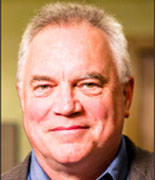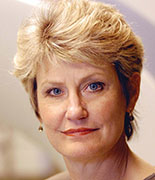Low-Dose CT Imaging Focus of RSNA/AAPM Symposium at RSNA 2018
BY JENNIFER ALLYN
August 31, 2018

Kinahan
Advances in low-dose CT, including early detection and characterization of lung cancer, are having a substantial impact on routine clinical practice and remain an important topic of research.
The applications, benefits and risks related to the use of reduced radiation doses in CT will be discussed at the RSNA/American Association of Physicists in Medicine (AAPM) Symposium, “State of the Art in CT Imaging” at RSNA 2018.
“The value and low or no-risk of appropriate low-dose CT imaging has been well-established,” said Paul E. Kinahan, PhD, moderator of this year’s symposium, to be held Tuesday, Nov. 27 in Room E451B.
Dr. Kinahan, vice chair for radiology research and head of the imaging research laboratory at the University of Washington, Seattle, is excited to introduce RSNA and AAPM members to new developments in low-dose CT while also tempering expectations due to the risk of compromising clinical performance.
“There are exciting new physics and clinical developments determining the relationships between lesion detection and dose, new classes of iterative CT image reconstruction algorithms and new lung nodule classification rules,” Dr. Kinahan said, “However, care must be taken to ensure that doses are not lowered to the level that clinical tasks are compromised.”
The applications, benefits and risks related to the use of reduced radiation doses in CT will be discussed at the RSNA/American Association of Physicists in Medicine (AAPM) Symposium, “State of the Art in CT Imaging” at RSNA 2018.
“The value and low or no-risk of appropriate low-dose CT imaging has been well-established,” said Paul E. Kinahan, PhD, moderator of this year’s symposium, to be held Tuesday, Nov. 27 in Room E451B.
Dr. Kinahan, vice chair for radiology research and head of the imaging research laboratory at the University of Washington, Seattle, is excited to introduce RSNA and AAPM members to new developments in low-dose CT while also tempering expectations due to the risk of compromising clinical performance.
“There are exciting new physics and clinical developments determining the relationships between lesion detection and dose, new classes of iterative CT image reconstruction algorithms and new lung nodule classification rules,” Dr. Kinahan said, “However, care must be taken to ensure that doses are not lowered to the level that clinical tasks are compromised.”

McCollough
Cynthia H. McCollough, PhD, will discuss important considerations regarding the use of low-dose CT, including diagnostic performance of the radiologist, during her symposium presentation, “CT Technology - and Dose - in the 21st Century.”
“With all the advances in CT over the last decade, including changes in scanner design, dual-energy CT and widespread adoption of iterative reconstruction and noise reduction techniques, body CT doses have fallen by over a factor of three since the early 80s,” said Dr. McCollough, president-elect of AAPM and a professor of biomedical engineering and medical physics at Mayo Clinic College of Medicine and Science in Rochester, MN.
“These advances increase the medical benefit and decrease the potential radiation risk associated with CT. Nevertheless, if the diagnostic quality is not adequate and the radiologist does not make the correct diagnosis, this can greatly jeopardize patient outcomes.”
Low-Dose CT in Lung Cancer
“With all the advances in CT over the last decade, including changes in scanner design, dual-energy CT and widespread adoption of iterative reconstruction and noise reduction techniques, body CT doses have fallen by over a factor of three since the early 80s,” said Dr. McCollough, president-elect of AAPM and a professor of biomedical engineering and medical physics at Mayo Clinic College of Medicine and Science in Rochester, MN.
“These advances increase the medical benefit and decrease the potential radiation risk associated with CT. Nevertheless, if the diagnostic quality is not adequate and the radiologist does not make the correct diagnosis, this can greatly jeopardize patient outcomes.”
Low-Dose CT in Lung Cancer

Aberle
Denise R. Aberle, MD, will discuss the current role of low-dose CT in lung cancer screening and early detection, including current approaches to the classification of indeterminate lung nodules.
Given the prominent role of semantic features in current diagnostic classification models of lung cancer, she will describe approaches to standardizing semantic characterization of lung nodules based on an illustrated lexicon in her presentation, “Contemporary CT of the Indeterminate Lung Nodule: Where We Are and Why it Matters.”
Dr. Aberle is professor of radiology and bioengineering at the University of California Los Angeles (UCLA), and vice chair for research in the Department of Radiological Sciences in the David Geffen School of Medicine at UCLA.
“My research has centered on oncologic imaging, particularly on the early detection of lung cancer and the use of qualitative and quantitative image features for lung cancer diagnosis and characterization,” Dr. Aberle said. “I am particularly interested in the use of low-dose CT to assist with the classification of indeterminate lung nodules, understanding the evolution from preneoplasia to early malignancy to advanced disease and the mechanisms for arresting disease with immunotherapies and chemo-immunotherapies.”
Dr. Aberle was the principal investigator of the ACRIN-NLST (American College of Radiology Imaging Network component of the National Lung Screening Trial), the NCI-sponsored randomized controlled trial that showed a reduction in lung cancer mortality with low-dose CT screening relative to chest radiography screening for lung cancer and which formed the basis for the adoption of low-dose CT screening in the U.S. She also plans to take her research in new directions.
“The validation of low-dose helical CT for lung cancer screening of high-risk individuals in the NLST led to a sea change in health policy on the early detection of lung cancer,” Dr. Aberle said. “Now the focus will be on how it will perform in nodule classification, particularly when integrated with clinical and molecular biomarkers of lung cancer in the setting of indeterminate lung nodules, and how it may enable the differentiation between indolent and aggressive lung cancers after initial diagnosis.”
Dr. McCollough agrees that CT colonography and CT screening for lung nodules are indications where low-dose CT has been the most successful. However, she cautions that for many other indications, low-dose CT may not be helpful.
“You usually have to trade off something when you lower the dose and you don’t want that to be diagnostic performance,” Dr. McCollough said. “Dose customization that is specific to the patient and to the reason for the exam, as well as technical advances such as tube current modulation and tube potential optimization, have the potential to help patients get a quality exam at lower doses.”
Given the prominent role of semantic features in current diagnostic classification models of lung cancer, she will describe approaches to standardizing semantic characterization of lung nodules based on an illustrated lexicon in her presentation, “Contemporary CT of the Indeterminate Lung Nodule: Where We Are and Why it Matters.”
Dr. Aberle is professor of radiology and bioengineering at the University of California Los Angeles (UCLA), and vice chair for research in the Department of Radiological Sciences in the David Geffen School of Medicine at UCLA.
“My research has centered on oncologic imaging, particularly on the early detection of lung cancer and the use of qualitative and quantitative image features for lung cancer diagnosis and characterization,” Dr. Aberle said. “I am particularly interested in the use of low-dose CT to assist with the classification of indeterminate lung nodules, understanding the evolution from preneoplasia to early malignancy to advanced disease and the mechanisms for arresting disease with immunotherapies and chemo-immunotherapies.”
Dr. Aberle was the principal investigator of the ACRIN-NLST (American College of Radiology Imaging Network component of the National Lung Screening Trial), the NCI-sponsored randomized controlled trial that showed a reduction in lung cancer mortality with low-dose CT screening relative to chest radiography screening for lung cancer and which formed the basis for the adoption of low-dose CT screening in the U.S. She also plans to take her research in new directions.
“The validation of low-dose helical CT for lung cancer screening of high-risk individuals in the NLST led to a sea change in health policy on the early detection of lung cancer,” Dr. Aberle said. “Now the focus will be on how it will perform in nodule classification, particularly when integrated with clinical and molecular biomarkers of lung cancer in the setting of indeterminate lung nodules, and how it may enable the differentiation between indolent and aggressive lung cancers after initial diagnosis.”
Dr. McCollough agrees that CT colonography and CT screening for lung nodules are indications where low-dose CT has been the most successful. However, she cautions that for many other indications, low-dose CT may not be helpful.
“You usually have to trade off something when you lower the dose and you don’t want that to be diagnostic performance,” Dr. McCollough said. “Dose customization that is specific to the patient and to the reason for the exam, as well as technical advances such as tube current modulation and tube potential optimization, have the potential to help patients get a quality exam at lower doses.”